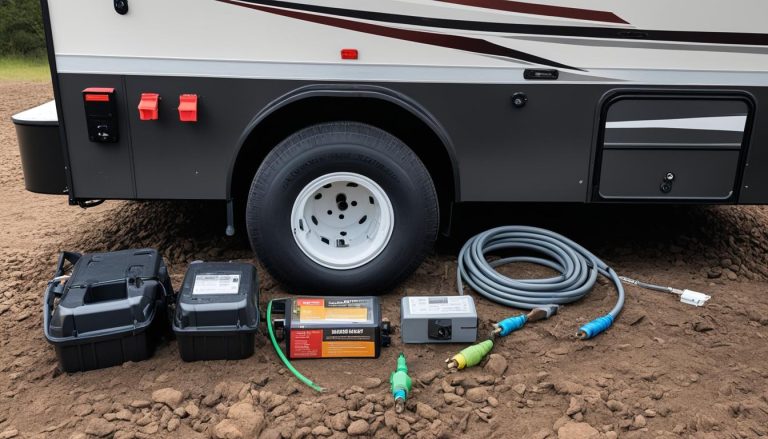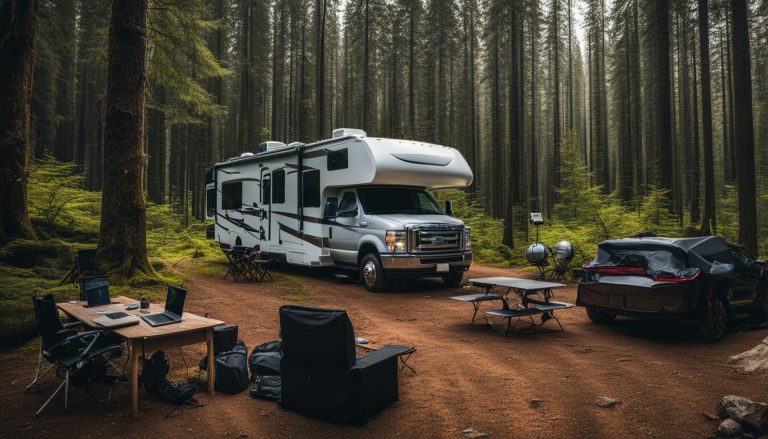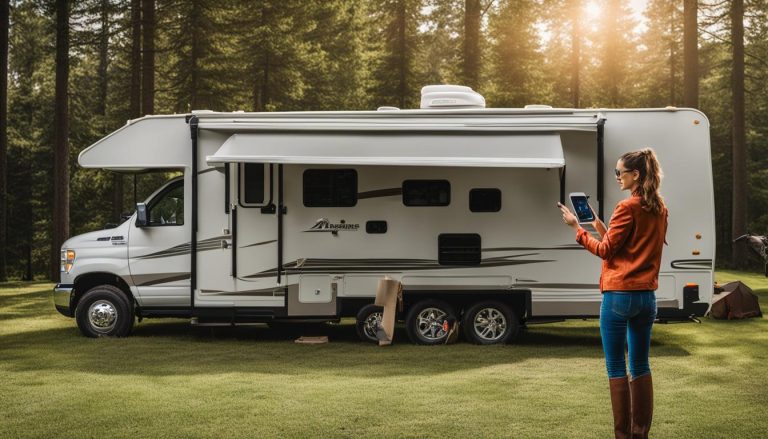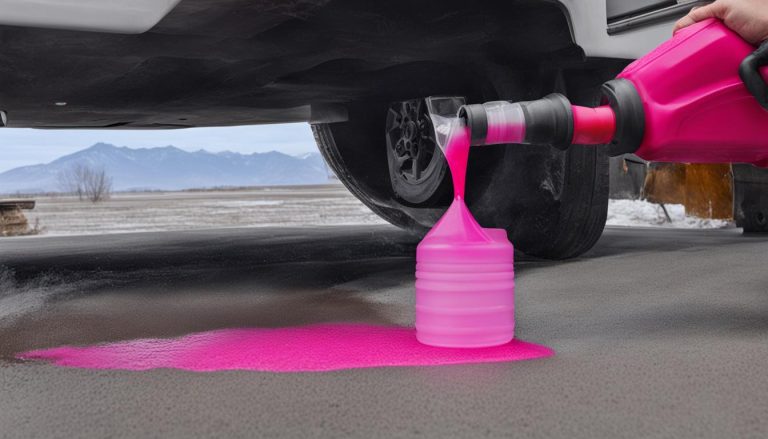RV Inverter Explained: Power Up Your Travels
gorvlifestyle.com and its partners may earn a commission if you purchase a product through one of our links
Are you an avid camper who loves the freedom of traveling off the grid? If so, you may have wondered how you can still use your favorite electrical appliances while enjoying the great outdoors. That’s where an RV inverter comes in handy.
An RV inverter is a device that converts the 12V DC power from your RV’s battery to 120V AC power, allowing you to power your 120V appliances and devices while off-grid. This means you can still use your laptop, coffee maker, microwave, and other modern conveniences even when you’re camping in remote locations.
So, how does an RV inverter work? It takes the 12V DC power from your RV’s battery bank and converts it to 120V AC power. The inverter increases the voltage of the battery’s DC power and modifies it to alternate between positive and negative cycles, creating an AC power supply that can safely power your 120V appliances.
Key Takeaways:
- An RV inverter converts 12V DC power from your RV’s battery to 120V AC power.
- It allows you to power your 120V appliances and devices while off-grid.
- An RV inverter works by increasing the voltage of the battery’s DC power and modifying it to alternate between positive and negative cycles, creating an AC power supply.
- Using an RV inverter depends on the type of inverter you have.
- It is generally not necessary to leave an RV inverter on all the time.
How Does an RV Inverter Work?
An RV inverter is a crucial component that allows you to power your 120V AC appliances and devices while off-grid. But how does it work? Let’s dive into the inner workings of an RV inverter.
At its core, an RV inverter takes the 12V DC power from your RV’s battery bank and converts it into 120V AC power. It accomplishes this transformation through a process called inversion.
When you connect your RV to a power source, the battery supplies 12V DC power. However, many of the appliances and devices in your RV require 120V AC power, just like the power supply in your home. That’s where the RV inverter comes in.
The inverter works by boosting the voltage of the battery’s DC power and modifying it to alternate between positive and negative cycles. This alteration creates a sinusoidal waveform that mimics the AC power supply found in homes. The resulting converted power is then used to safely and efficiently power your 120V AC appliances such as TVs, computers, and coffee makers.
Some RV inverters also feature a bypass circuitry that allows them to go into “Standby Mode” when connected to shore power. In this mode, the inverter reduces power draw from the batteries and diverts the shore power directly to the RV’s circuits. This feature helps conserve battery life and provides a seamless transition between power sources.
| RV Inverter Working Principle | Benefits |
|---|---|
| Step 1: The inverter receives 12V DC power from the RV’s battery bank. | – Converts battery power to 120V AC power – Allows use of 120V AC appliances while off-grid |
| Step 2: The inverter boosts the voltage and modifies it to alternate between positive and negative cycles. | – Creates a sinusoidal waveform – Matches the AC power supply in homes |
| Step 3: The inverter safely powers 120V AC appliances. | – Enables usage of TVs, computers, and more – Provides seamless power transition with a standby mode |
Understanding how an RV inverter works allows you to make informed decisions about its installation, usage, and maintenance. Now that you know the inner workings of an RV inverter, let’s explore the differences between an RV inverter and an RV converter in the next section.
Difference Between an RV Inverter and RV Converter
Many people confuse RV inverters with RV converters, but they are actually two different devices that serve different purposes.
An RV inverter converts 12V DC power from the battery to 120V AC power for powering appliances. This allows you to use your RV’s batteries to power 120V appliances such as TVs, microwaves, and laptops, even when you’re off-grid.
An RV converter, on the other hand, does the opposite. It takes 120V AC power from shore power or a generator and converts it to 12V DC power to supply onboard devices, such as lights, fans, and water pumps. The converter ensures that your 12V systems, like lighting and water pumping, are powered effectively.
“It’s important to understand the difference between an RV inverter and converter to ensure you have the right equipment to meet your power needs.”
Comparison: RV Inverter vs. RV Converter
| RV Inverter | RV Converter |
|---|---|
| Converts 12V DC power to 120V AC power | Converts 120V AC power to 12V DC power |
| Powers 120V appliances | Powers 12V systems and devices |
| Enables off-grid power usage | Utilizes shore power or generator for power |
As you can see, the difference between an RV inverter and converter lies in the direction of power conversion and the type of devices they power. An inverter allows you to use your RV’s batteries for 120V power, while a converter ensures your 12V systems are supplied with power from an external source.
It’s essential to consider your power needs and the appliances or systems you want to power when choosing between an RV inverter and converter. Understanding their differences will help you make an informed decision and ensure you have the right equipment for your RV adventures.
Pure Sine Wave vs Modified Sine Wave
When it comes to RV inverters, there are two primary types to consider: pure sine wave and modified sine wave. Understanding the difference between these two types is important for ensuring compatibility with your 120V appliances and electronics.
Pure Sine Wave Inverter
A pure sine wave inverter produces a power output that mimics the clean and stable 120V AC power found in homes. This type of power is considered high-quality and is compatible with all 120V appliances and electronics. Pure sine wave inverters provide a smooth and consistent power flow, which helps prevent disturbances, noise, and potential damage to your devices.
Modified Sine Wave Inverter
On the other hand, a modified sine wave inverter produces a power output that is not as pure as the sine wave inverter. The waveform of the power output has sharper cutoffs and more abrupt changes in power. While modified sine wave inverters are more cost-effective, they may cause interference or even damage certain devices, especially those with sensitive electronics. Some appliances, such as refrigerators, may also not function as efficiently with a modified sine wave power supply.
When deciding between a pure sine wave inverter and a modified sine wave inverter, it’s important to consider the types of devices you plan to power in your RV. If you have sensitive electronics or appliances that require a high-quality power supply, investing in a pure sine wave inverter is recommended. While pure sine wave inverters tend to be more expensive, they provide a higher quality power output and offer better compatibility with a wider range of devices.
Ultimately, the choice between these two types of inverters depends on your specific needs and budget. If you have a lot of sensitive electronics or appliances, it may be worth the investment to opt for a pure sine wave inverter. However, if you primarily use basic appliances and are looking for a more budget-friendly option, a modified sine wave inverter could still meet your needs.

With a better understanding of the difference between pure sine wave and modified sine wave inverters, you can make an informed decision when choosing the right power solution for your RV.
How to Use an RV Inverter
Using an RV inverter is a straightforward process that depends on the type of inverter you have. Whether you have a portable inverter or an installed one, the steps below will guide you in harnessing its power for your RV adventures.
For Portable Inverters:
- Locate the 12V socket in your RV.
- Plug your portable inverter into the 12V socket.
- Turn on the inverter, usually through a power switch or button.
- Plug your devices directly into the inverter’s AC outlets. Ensure the wattage of your devices does not exceed the inverter’s capacity.
With these simple steps, you can enjoy the convenience of powering your devices while being off-grid.
For Installed Inverters:
- Find the control panel inside your RV where the inverter is connected.
- Turn on the inverter using the control panel’s power switch or button.
- Identify the outlets in your RV powered by the inverter. These outlets are typically labeled or connected to the inverter’s circuit.
- Plug your devices into the designated outlets. Remember to check the wattage to avoid overloading the inverter.
It’s important to note that not all outlets in your RV may be powered by the inverter. Some circuits may be dedicated to shore power or other power sources. Refer to your RV’s manual for a clear understanding of the power distribution system.
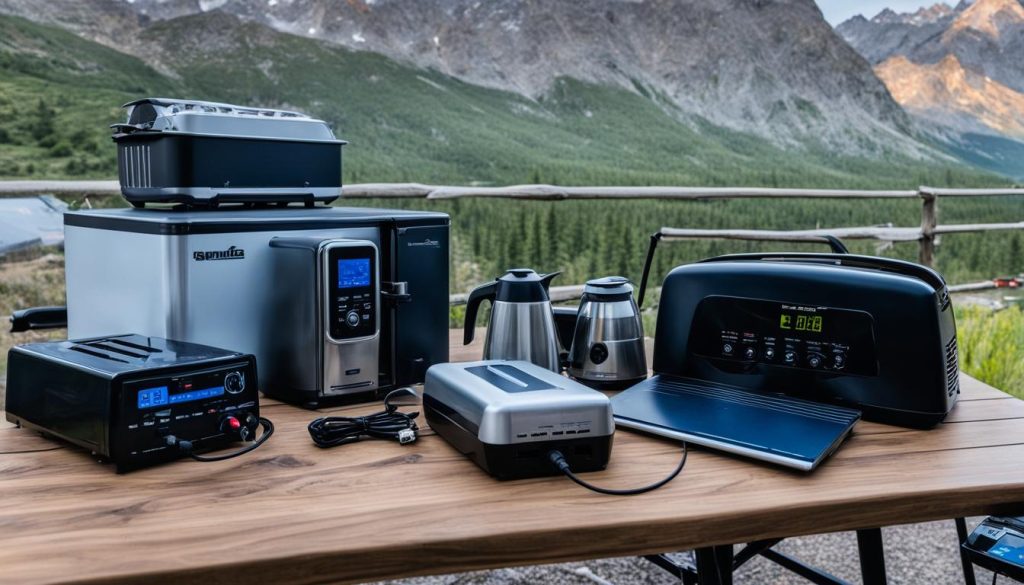
“Using an RV inverter is a breeze! Simply follow these steps to unleash the power of your inverter and enjoy the comforts of home on your travels.”
Should I Leave My RV Inverter On All the Time?
- It is generally not necessary to leave an RV inverter on all the time.
- In fact, the inverter will draw power even when not in use, so it is best to turn it off when it is not needed to power your devices.
- However, if you have a residential refrigerator in your RV that requires 120V power at all times, then leaving the inverter on may be necessary to provide continuous power to the refrigerator.
- In this case, make sure the inverter is properly sized to handle the power requirements of your refrigerator and monitor your battery capacity to ensure you do not drain them too quickly.
Leaving an RV inverter on all the time can lead to unnecessary power consumption. When the inverter is turned on, it continues to draw a small amount of power even when there are no devices plugged into it. This can drain your RV’s battery over time. To conserve power and prolong battery life, it is advisable to turn off the inverter when not in use.
However, there are situations where leaving the inverter on is necessary. If you have a residential refrigerator in your RV that requires continuous power, you will need to leave the inverter on to ensure the refrigerator remains operational. In this case, it is crucial to ensure that your inverter is properly sized and can handle the power requirements of the refrigerator without draining the battery too quickly.
It is essential to monitor your battery capacity regularly. Leaving the inverter on continuously can drain the batteries faster, especially if they are not being charged simultaneously. Be mindful of your power consumption and battery levels to avoid any unexpected power outages during your travels.
What Size Inverter Do I Need for My RV?
When it comes to choosing the right inverter for your RV, it’s important to consider the power requirements of your appliances and devices. To determine the size of the inverter you need, start by calculating the total wattage of the devices you plan to power with it. Add up the wattage ratings of each device to get the total wattage.
Once you have the total wattage, choose an inverter that can handle at least that amount. It’s recommended to select an inverter with a slightly higher wattage rating to account for power surges and to ensure that the inverter is not overloaded. Keep in mind that running high-power appliances like air conditioners or microwaves will require a larger capacity inverter and a more robust battery bank to provide sufficient power.
By selecting an inverter that matches your power needs, you can ensure that you have enough power to run your appliances and devices while off-grid. It’s always a good idea to consult the manufacturer’s specifications for your appliances to determine their power requirements and to seek professional advice if needed. With the right inverter, you can enjoy the comforts of home even when you’re on the road.
FAQ
What is an RV inverter?
An RV inverter is a device that converts the 12V DC power from your RV’s battery to 120V AC power, allowing you to power your 120V appliances and devices while off-grid.
How does an RV inverter work?
An RV inverter works by taking the 12V DC power from your RV’s battery bank and converting it to 120V AC power. It does this by boosting the voltage of the battery’s DC power and modifying it to alternate between positive and negative cycles, creating a sinusoidal waveform that matches the AC power supply found in homes.
What is the difference between an RV inverter and RV converter?
An RV inverter converts 12V DC power from the battery to 120V AC power for powering appliances, while an RV converter does the opposite. A converter takes 120V AC power from shore power or a generator and converts it to 12V DC power to supply onboard devices, such as lights, fans, and water pumps.
What is the difference between a pure sine wave and modified sine wave inverter?
A pure sine wave inverter produces a power output that matches the 120V AC power found in homes, making it compatible with all 120V appliances and electronics. A modified sine wave inverter produces a power output that is not as pure, which can cause interference or damage to certain devices, especially those with sensitive electronics.
How do I use an RV inverter?
If you have a portable inverter, you simply plug it into the 12V socket, turn it on, and then plug your devices directly into the inverter’s AC outlets. If your RV came with an inverter installed, it is likely connected directly to the RV’s battery bank. In this case, you would use the inverter by turning it on using the control panel inside the RV and plugging your devices into the outlets powered by the inverter.
Should I leave my RV inverter on all the time?
It is generally not necessary to leave an RV inverter on all the time. In fact, the inverter will draw power even when not in use, so it is best to turn it off when it is not needed to power your devices. However, if you have a residential refrigerator in your RV that requires 120V power at all times, then leaving the inverter on may be necessary to provide continuous power to the refrigerator.
What size inverter do I need for my RV?
The size of the inverter you need for your RV depends on the power requirements of your appliances and devices. To determine the size, you first need to calculate the total wattage of the devices you plan to power with the inverter. Add up the wattage ratings of each device and choose an inverter that can handle at least that total wattage.


